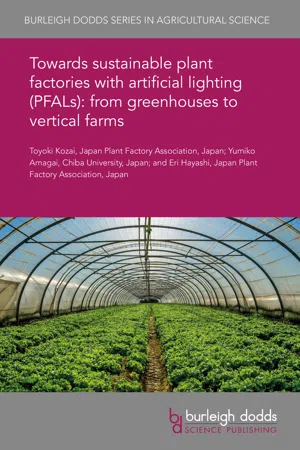
Towards sustainable plant factories with artificial lighting (PFALs): from greenhouses to vertical farms
- English
- PDF
- Available on iOS & Android
Towards sustainable plant factories with artificial lighting (PFALs): from greenhouses to vertical farms
About this book
Plant factories with artificial lighting (PFALs) have hitherto proved too costly to be economically viable, consuming too much electricity to be considered truly sustainable. However, recent advances are changing this, and the potential advantages of PFALs are making them an attractive option. This chapter discusses the requirements of sustainable plant production systems, exploring the potential and actual benefits of PFALs. The chapter considers the resource consumption, production cost and cost performance associated with current PFALs, as well as methods for reducing resource consumption and production costs. Finally, the chapter examines future challenges of environmentally and economically sustainable plant production for smart PFALs.
Frequently asked questions
- Essential is ideal for learners and professionals who enjoy exploring a wide range of subjects. Access the Essential Library with 800,000+ trusted titles and best-sellers across business, personal growth, and the humanities. Includes unlimited reading time and Standard Read Aloud voice.
- Complete: Perfect for advanced learners and researchers needing full, unrestricted access. Unlock 1.4M+ books across hundreds of subjects, including academic and specialized titles. The Complete Plan also includes advanced features like Premium Read Aloud and Research Assistant.
Please note we cannot support devices running on iOS 13 and Android 7 or earlier. Learn more about using the app.
Information
Table of contents
- 1 Introduction
- 2 Characteristics of PFALs
- 3 Resource consumption by resource elements: simulation studies
- 4 Production cost and its components
- 5 Reducing electricity consumption and improving cost performance
- 6 Challenges for the next-generation smart PFALs
- 7 Future trends and conclusion
- 8 Acknowledgements
- 9 References